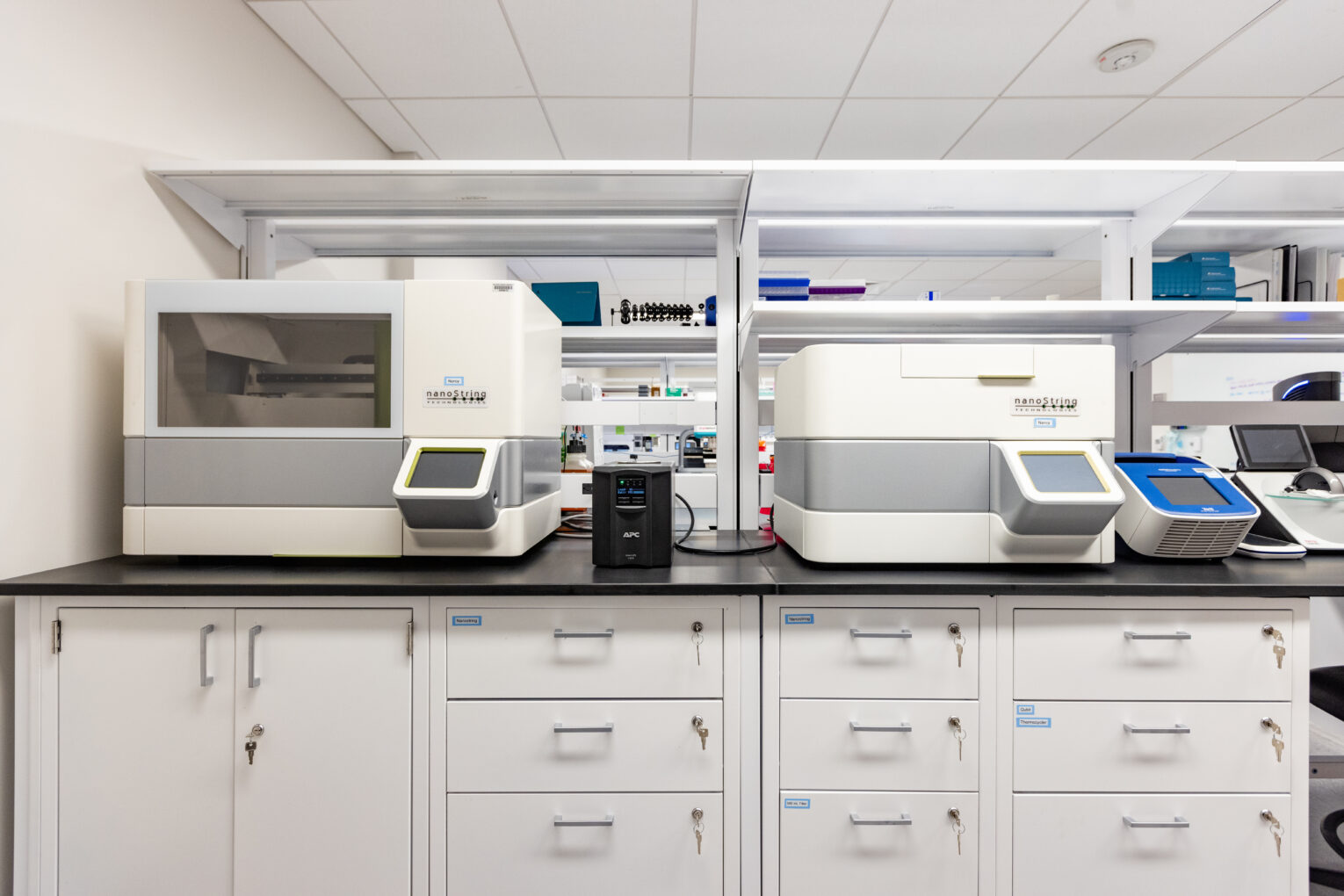Equipment and Methods – PRECEDE Biomarkers Laboratory
Equipment and Methods
Quanterix Simoa HD-X Analyzer – is used for detecting proteins within the detections needed in peripheral samples of blood, sweat, and other biological samples. The kits and other reagents are only available from the Quanterix. Protein biomarker measurement is performed on the Simoa HD-X which allows for multiplex detection at single protein molecule level. Allows for detection of thousands of single protein molecules simultaneously using the same reagents as the current standard method for detecting proteins, ELISA. Single protein molecules are captured and labeled on beads using standard ELISA reagents. The Simoa HD-X Analyzer uses arrays of femtoliter-sized reaction chambers that can isolate and detect single enzyme molecules. After fluorescent labeling of the proteins, The Simoa HD-X Analyzer enables protein concentrations to be determined digitally rather than by using the total analog signal, called digital ELISA. By isolating and detecting single immunocomplexes in arrays of femtoliter-volume wells, digital ELISA enables clinically important proteins in serum to be measured at sub femtomolar concentrations that allows peripheral samples of blood to approximate central activity of neuropeptides.

Quanterix Simoa SP-X Imaging and Analysis System- is used for detecting proteins within peripheral samples of blood, sweat, and other biological samples. The kits and other reagents are only available from Quanterix. The Corplex 10 kits allow for 10 biomarker measurements at once using their kits and instrumentation. It uses planar immunoassay technology with an ultrasensitive multiplexing platform. Proprietary high-precision digital nanofluidic antibody deposition technology to provide surface chemistry optimization, with low background noise and excellent assay precision and accuracy. Uses a unique spot design on the plates with capture antibodies per analyte, making it possible to perform up to a 10-plex assay in any well, saving sample volume, time, and cost. The Simoa planar approach utilizes the unique shaking protocols with an efficient vortex style interactions to improve collisions between target analytes and the capture antibodies within the plate forming antibody/antigen complexes, providing exquisite assay sensitivity. The clinical use of protein biomarkers to differentiate between healthy and disease states, and to monitor disease progression, requires the measurement of low concentrations of proteins in serum, plasma, and other biological fluids such as sweat and CSF. Current immunoassays typically measure proteins at concentrations above 10-12 M. The ability to detect low abundance proteins in biological fluids like serum/plasma/sweat/csf has the potential to facilitate earlier diagnosis and treatment of PTSD and PCS as well as other traumas.

Nanostring Prep Station and nCounter Max Analyzer– novel digital barcode technology which is an integrated system comprised of a fully automated Prep Station and Digital Analyzer used in conjunction with nCounter Master Kits containing the necessary reagents, cartridges and consumables, and nCounter CodeSets (for research use only). These CodeSets may be custom ordered or selected from a menu of pre-designed panels. CodeSets can be designed to simultaneously target more than one type of biomolecule. The nCounter MAX employs a novel digital barcode technology. These barcodes hybridize with target molecules, and unique digital barcodes are then directly counted using single-molecule imaging to yield precise and sensitive quantification Up to 800 targets can be measured simultaneously in a single sample, and up to 12 samples can be assayed in a single run. The nCounter Analysis System provides data on various research involving miRNA analysis of biofluids to determine genetic pathways and gene functions within biofluids in reference to various biomarkers following injury.

Meso Scale Diagnostics Meso QuickPlex SQ120- The QuickPlex instrument offers affordable access to high-performance electrochemiluminescence immunoassays. The combination of rapid read times and the ability to perform multiple, simultaneous tests on a single sample increases productivity, saves sample, and delivers results quickly. The QuickPlex instrument has a wide menu of commercially available assay kits and a full line of components and reagents for developing your own assays. ECL detection for best sensitivity and dynamic range, Single and multiplex assays, Single-well-read mode for ultimate performance, Ultra-fast read times (90 seconds per plate)

Exosome Purification/Validation Equipment
ExoView R200– is a unique, automated platform for the multi-level characterization of extracellular vesicles. The technology is unique in its operation and many of the features and benefits of the technology are not available in other commercially available characterization tools. Automatic measurement of up to 16 samples with R200 microscope reader. Affinity-based capture and detection of EVs that does not require pre-purification of sample. Cell culture supernatant, plasma, serum, urine, saliva and other biological fluids have been tested and can be directly measured without the need for sample purification. The ability to detect rare events down to 6exp6 EVs per ml. The ability to measure up to 5 biomarkers per single EV. The ability to measure with single-copy sensitivity, protein biomarkers on individual EVs. Validated protocols for the detection and quantification of EVs expressing ubiquitous tetraspanin markers (CD9, CD63, CD81). The ability to work with low sample volumes of ≤ 35ul

LabSpinner (Exodisc)– is a centrifugal microfluidic device that can separate EVs by TFF with nano-sized filters. Each Exodisc has 6 nano-sized filters (anodic aluminum oxide membrane) with a diameter of 13 mm. EV separation on Exodisc.

MACSQuant X– manufactured by Miltenyi Biotec, Inc. has engineered from the ground up as a compact flow cytometer made to provide speed and reliability in high-throughput screening. The MACSQuant X has been designed to meet high-throughput cell analysis needs for the most challenging large-scale screening settings. It is a robust, automated flow cytometer capable of processing up to 9,200 samples per day (96-well plate within 15 minutes, 384-well plate in under 60 minutes) with seamless integration into a variety of liquid handling systems. It uses 3 laser light settings and can be useful for studies including cellular therapy, i.e., chimeric antigen receptor (CAR) T cell manufacturing, toxicological assays, whole blood analysis, cell counting, rare cell analysis, small particles/exosomes, and cytokine arrays.

